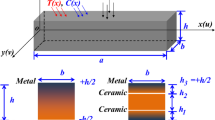Abstract
Two measures of fracture toughness have been investigated. The first is the Cotterell's essential work of fracture (w e) which reflects the energy absorbed in the process of localized necking and decohesion occurring within the crack tip region. The second is the familiar critical energy dissipation rate associated with the onset of crack extension and commonly designated by J c. Total of 48 fracture tests have been performed on thin aluminum double-edge-notched panels and thin compact tension specimens with varying crack size-to-ligament ratios. In a simple experimental procedure it has been established that both measures are equivalent, at least under the plane stress conditions, and that they both represent the fraction of energy which is transmitted through the plastic deformation field into the crack tip region. The ratio “essential work of fracture/total work of fracture” has been suggested as a quantitative measure of the energy transmission process. Certain predictions are made concerning variations of the energy transmission factor (ETF) during the stable phase of ductile fracture propagation.
Résumé
On étudie deux mesures de la ténacité à la rupture. La première est le travail essentiel de rupture de Cotterell (w e) qui représente l'énergie absorbée au cours du processus de striction et de décohésion localiseés qui se produit dans la région de l'extrémité d'une fissure. La deuxième est la notion familière de vitesse critique de dissipation d'énergie associée au démarrage de l'extension d'une fissure, qui est couramment représentée par J c. On a procédé à un total de 48 essais de rupture sur des panneaux minces d'aluminium présentant une double entaille de bord, et sur des éprouvettes minces de traction compactes présentant divers rapport de longueur de fissure sur longueurs de ligaments. Par une procédure expérimentale simple, on a établi que les deux mesures de la ténacité sont équivalentes, du moins en état plan de tension, et qu'elles représentent toutes deux la fraction d'énergie qui est transmise au travers du champ de déformation plastique dans la zone de l'extrémité de la fissure. On suggère comme mesure quantitative du processus de transmission d'énergie d'utiliser le rapport “travail essentiel de rupture/travail total de rupture”. Diverses prédictions sont faites en ce qui concerne les variations du facteur de transmission d'énergie au cours de la phase stable de propagation d'une rupture ductile.
Similar content being viewed by others
References
B. Cotterell, in Fracture Mechanics and Technology, Vol. 2, Ed. G.C. Sih and C.L. Chow, Sijthoff and Noordhoff International Publishers (1977) 785–795.
V.L. Gel'miza and D.M. Shur, Problemy Prochnosti, No. 5 (1974) 85–87 (in Russian).
A.A.Willoughby, P.L.Pratt and C.E.Turner, International Journal of Fracture 17 (1981) 449–465.
K.B.Broberg, International Journal of Fracture 17 (1977) 837–859.
M.P.Wnuk, in Proceedings of International Conference on Dynamic Crack Propagation Ed. G.C.Sih, Noordhoff, Leyden, The Netherlands (1972) 273–280.
D.S.Dugdale, Journal of the Mechanics and Physics of Solids 8 (1960) 100–104.
B.A.Bilby, A.H.Cotterell, K.H.Swinden, Proceedings Royal Society, A., 279 (1963) 1–9.
M.P.Wnuk, International Journal of Fracture Mechanics 7 (1971) 383–407.
M.P.Wnuk, International Journal of Fracture Mechanics 19 (1979) 553–581.
C.E. Turner, in Fracture Mechanics: Twelfth Conference, ASTM STP 700 (1980) 314–337.
C.E. Turner, in Fracture Mechanics, ASTM STP 677 (1979) 614–628.
P.C. Paris, H. Ernst and C.E. Turner, in Fracture Mechanics: Twelfth Conference, ASTM STP 700 (1980) 338–351.
W.J.Drugan, J.R.Rice and T.L.Sham, Journal of the Mechanics and Physics of Solids 30 (1982) 447–473.
Author information
Authors and Affiliations
Additional information
On leave from The University of Wisconsin-Milwaukee
Rights and permissions
About this article
Cite this article
Wnuk, M.P., Read, D.T. Essential work of fracture (w e) versus energy dissipation rate (J c) in plane stress ductile fracture. Int J Fract 31, 161–171 (1986). https://doi.org/10.1007/BF00018925
Received:
Revised:
Issue Date:
DOI: https://doi.org/10.1007/BF00018925




